Outside of Looney Tunes, you might not know the difference between a coyote, dingo, fox, wolf, jackal, or mangy stray dog. They all belong to the canine family, but there have certain distinct differences. Coyotes are an indigenous American species and play a big cultural role.
Among certain Native American communities, coyotes were seen as trickster spirits. Lots of folk tales revolve around this creature, which was once known as an American Jackal, brush wolf, or prairie wolf. And while they’re not endangered, it’s still considered kosher to use humane hunting methods. So let’s look into some helpful tips for live trapping coyotes.
1. Talk to Animal Control
There are lots of different situations where you may want to live-trap a coyote. Maybe it’s a seasonal job on a chicken farm. Or maybe it’s your ducks and sheep being attacked. You may have the skills to catch the animal yourself, but you should still call your local animal office.
They can tell you whether there are any local laws about coyote hunting and trapping. In some places, certain trapping methods are illegal. In others, you risk getting attacked by PETA. And in others, you can use any kind of trap, as long as it has your name and address.
2. Make a Coyote Date
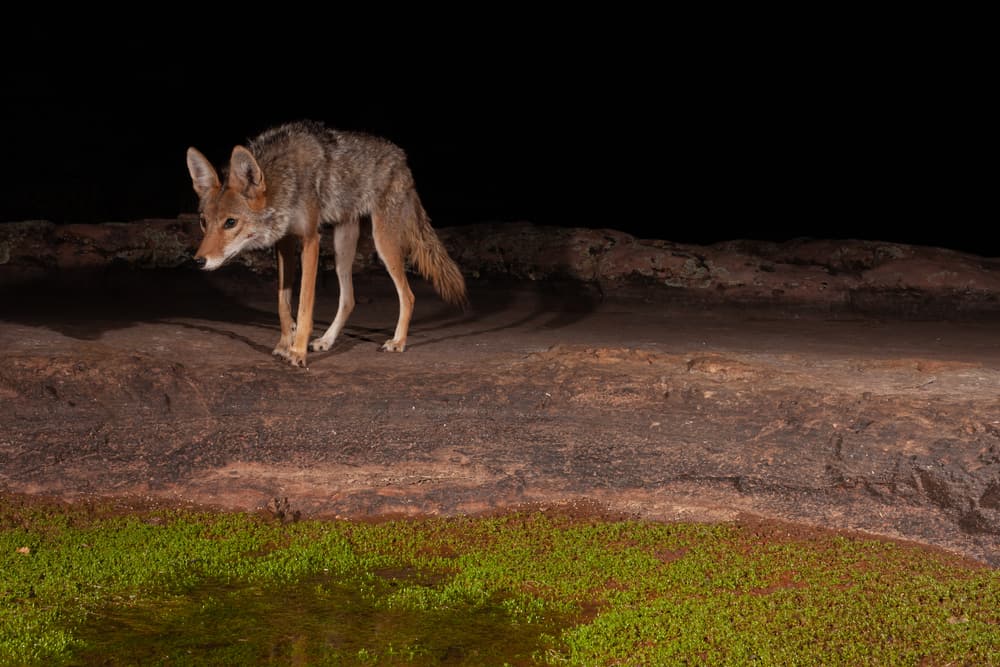
Some people trap coyotes for fur or meat while others just want them dead so their cattle can stay safe. So before you check on tips to live-trap coyotes, decide what you’ll do with it once you catch it. You can still kill it later, but since you want to live-trap it, don’t use a kill-trap.
Avoid snares and lethal traps as well, because the coyote may still end up dead as it tries to escape. If you’re selling the coyote, handing it to a zoo, or giving it to Animal Control, talk to them about coyote collection, euthanasia, feeding, and other details before you set the trap.
3. Use a Padded Trap
On average, coyotes are a little smaller than wolves. Depending on their age, gender, and sub-species, they can be anything from 8 to 20 kilos (roughly 15 to 50lbs). So a mid-sized coil spring trap should comfortably catch one. But you want a trap with rubber lining on its teeth.
The padding is less likely to break the coyotes’ skin or bones and is far gentler than a trap with sharp, exposed claws. You may wonder why you can’t just kill the coyote. It’s not illegal, but many trappers prefer to sell the coyote to an animal reserve or dog trainer for exercise.
4. Position it Right
Coyotes prefer to run in the open plains, so setting a trap in a forested area or among the bushes is not a smart tip for live trapping coyotes. They won’t go near it and you’ll end up with raccoons and rodents instead. Coyotes prefer to crouch near cattle trails and fences.
Reason being coyotes are sprinters. They attack from the front, so they hunt in places with a clear view and large chasing fields. So if they’re after your animals, they’ll hang out at the border of your pasture. That’s where you should set your traps if you want to get them alive.
5. Bury the Trap
Small burrowing animals are important prey for coyotes. So one sure-fire tip to live-trap a coyote is to dig a hole, put some bait in it, leave the hole uncovered, and sink a spring-loaded trap in front of the hole. As your prey approaches the hole’s entrance, pop goes the coyote!
You’ll need a humane trap if you’re using a buried position because anything else could trip it. Besides, you don’t want to deal with the mess of a mangled creature so padded traps are best. And you’ll need to calculate carefully. The soil above the trap could mess with the pressure!
6. Use a Hanging Lure
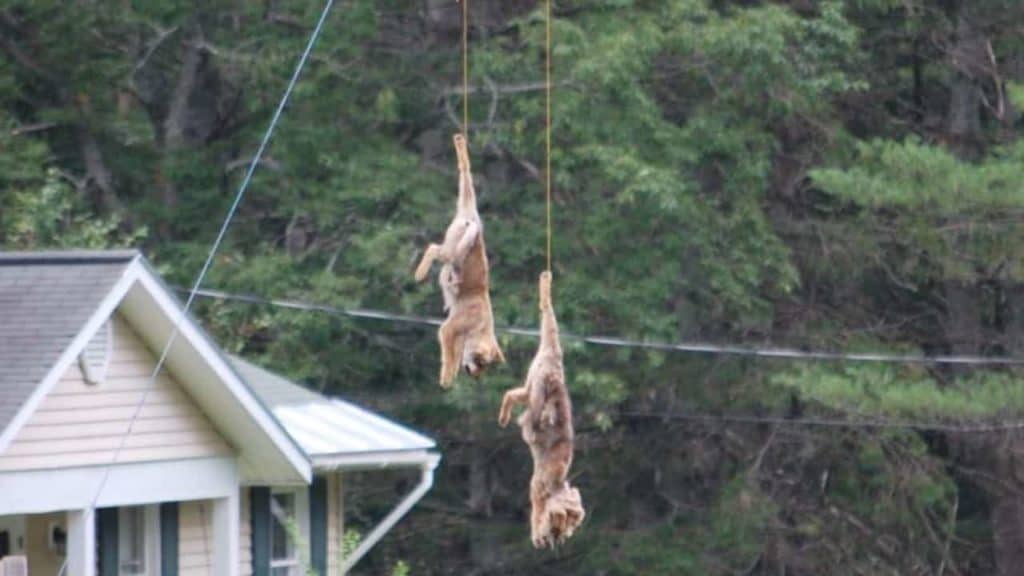
We’ve mentioned that coyotes prefer an open plateau so they can see their meal tickets coming. It helps them spot predators too! So if you happen to place a floating or flying piece of bait, the coyote would see it from a long way off. This type of lure is useful for flat traps.
A flat trap is still spring-loaded, but it sits on the surface of the ground. So you’ll want to position it at a spot where coyotes regularly pass. You can track their droppings to find the exact location. Place a hanging lure above the trap then cover the trap with leaves and grass.
7. Check your CCTV
It may seem like a strange idea, but many of today’s farms have cameras set up. And with the improved technology of smartphones and remote security systems, you can get quite a set-up on the cheap. Meaning your CCTV might show you exactly how the coyote sneaks in.
Maybe it slips through a crack in the wall or jumps very a rail fence. Mount a trap in that entryway and camouflage it carefully so the coyote can’t tell the difference. Then the next time it ‘knocks’ on its usual front door to gain access, it will land straight into your trap.
8. Try Getting a Cage
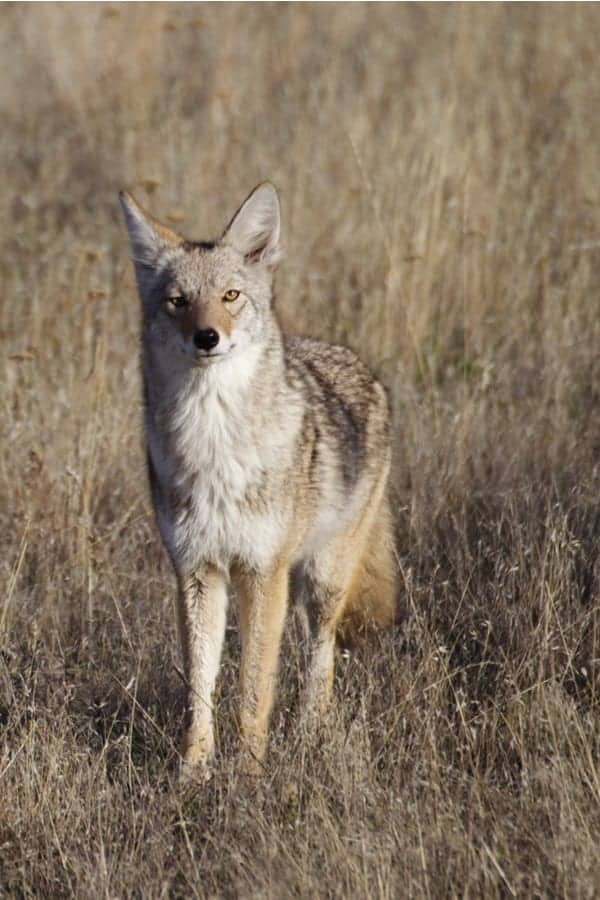
One of the commonest tips for live-trapping coyotes is to use cages. The type of humane cage that’s used to catch stray cats and dogs. They’re commonly used for trap, neuter, and release campaigns. You just have to get one that’s big enough for the coyote you’re hunting down.
Urban coyotes are fairly familiar with human behavior, so they often manage to outwit a cage trap. You may have to try different kinds of traps and bait before you succeed. It’s also helpful to camouflage the trap. Try placing one next to your chicken coop with live bird bait.
9. Level the Ground
Coyotes like to hang out on higher ground so they can survey their territory and surrounding areas. They don’t like trees – they’re happier with a cliff or ridge for a better view. And they can hunt in the snow. Those craggy rocks and fluffy snow force coyotes to be quite surefooted.
Meaning they can detect the slightest shift on the ground below them. So before you mount your trap, make sure the ground is sturdy and stable. And lay the trap completely flat, even if it’s covered. If the ground snaps or sinks, the coyote is likely to dash off and dodge the trap.
10. Avoid Pits and Snares
A coyote is unlikely to fall into a pit trap or deadfall trap because they’re quick and quite alert. But if you have them set up for other animals, don’t put spikes in the trap. After all, you want tips for live-trapping coyotes, and those sharp points are unlikely to spare their lives.
You should avoid snare traps too because while these can be effective, the coyote is likely to strangle themselves before you come to check on the trap. If you’re selling the coyote, it may be used to train hunting dogs, so use a trap that will preserve its feet and don’t break its legs.
11. Call them for Seconds
If you have a coyote problem, you may find droppings and half-eaten carcasses scattered across your land. And you may feel frustrated and annoyed because those kills aren’t hidden. Coyotes can run up to 40mph and they prefer open pastures and areas with minimal cover.
This seems counter-intuitive – most predators want those hidden spots. It may explain why we personify coyotes and consider them cunning and brazen. Either way, take one of their previous kills and use it as bait. They often come back to spots where they’ve seen success.
12. Dodge the Birds
While a coyote will be attracted to a scent of an animal it killed, other scavengers will be too. This may include other coyotes, which is fine. But if you want to catch a specific coyote that’s been attacking your livestock and you trap a different one, the original pest will come back.
It may be best to hire a professional trapper that can identify distinct coyotes and tell them apart. Your carcass bait will attract birds and raccoons who could all trip the trap and warn off the coyote. Set the trap 30 yards from the bait so you can catch the coyote as it sprints past.
13. Use the Right Trap Size
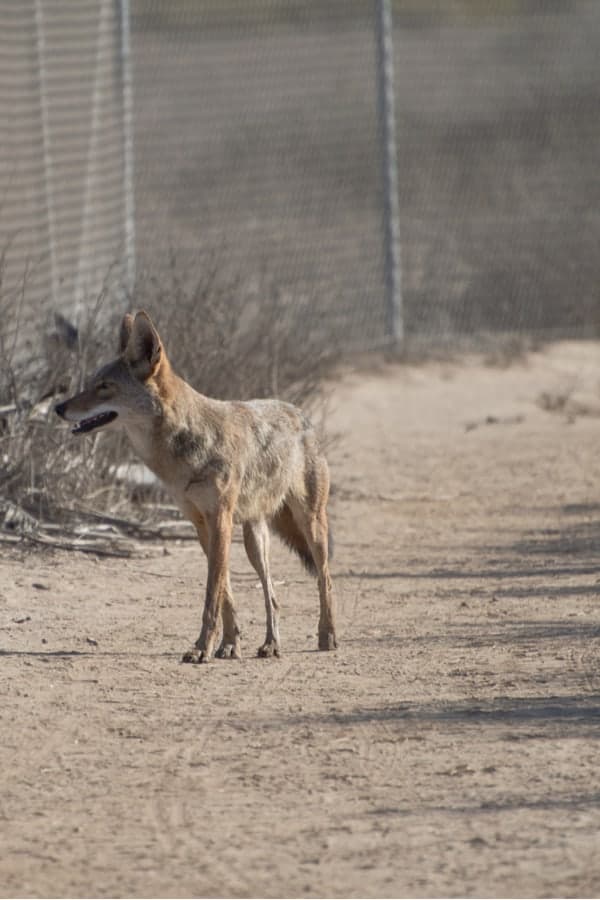
The size of a coyote has a wide range. And there may be more than one coyote in your neighborhood, so setting multiple traps is a good idea. But regardless of the target’s dimensions, your trap only needs to be large enough to gently, firmly snag the coyote’s foot.
If you use a coil trap, try a Number 3 or Number 4. When this trap is open, it has a diameter of about half a foot. That should be enough to live-trap any coyote. But it could grab your cat or dog’s legs too. And kids can get hurt just as easily. Cordon off the trapping area to be safe.
14. Practice Hygiene
You’re looking for tips for live-trapping coyotes. So you’re likely to get a rubber-padded offset trap that has been successful with coyotes before. You may not think the trap needs cleaning because it didn’t injure the coyote so it doesn’t have any blood or bone on it, just coyote fur.
But before you re-use the trap, you need to clean and disinfect it. Why? You (or the previous trapper) handled the trap, so it has a human scent on it. It may also have traces of ‘fear hormones’ from its previous occupants. Those smells may warn your target to stay far away.
15. Mask the Scent
Boiling your offset trap or coil trap is the best way to disinfect it. And you can bait the trap to lure your prey. But you can also use coyote fragrances as bait. This might include urine or coyote glands, and you can get them from your local wildlife service or friendly trappers.
You might think this would scare off the coyote because it means there’s a rival in the area. But coyotes are opportunistic hunters, so if they find an easy meal, they’ll take it. Besides, it proves a fellow coyote successfully killed in that spot, which makes it a prime feeding ground.
16. Get Help With Collection
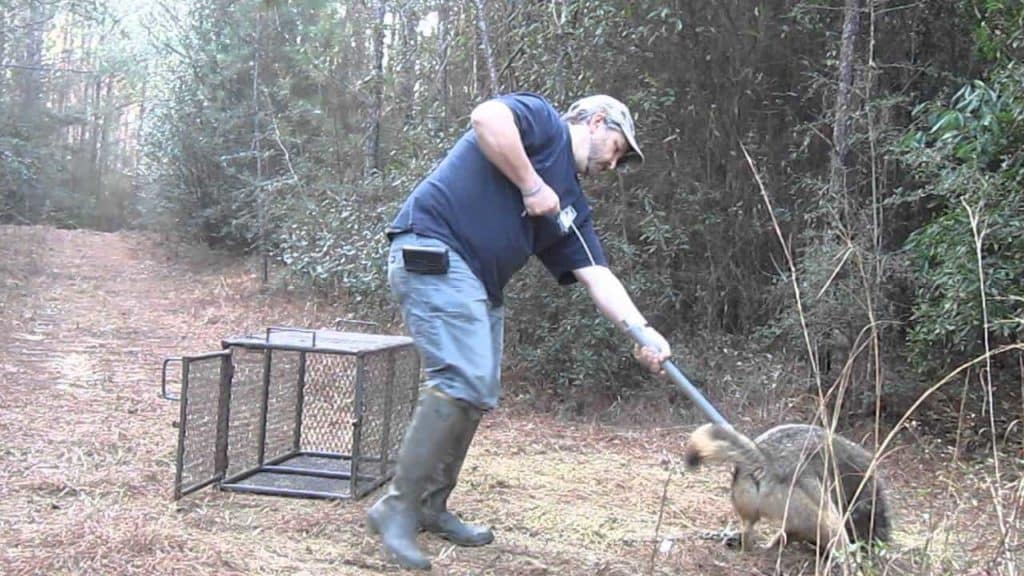
Setting and baiting coyote traps is fairly easy. But tips to live-trap a coyote are sometimes silent on the aftermath. Remember, you’re catching a wild canine that could have rabies, parasites, nearby cousins attempting to save it, and a nasty mood from struggling so long.
Any scratch or bite from the coyote can do serious damage. So once you’re sure the coyote is caught, call a trained trapper or wildlife ranger to help you get it out of the trap unharmed. They might tranquilize the animal or use a looped pole to catch and remove the coyote.
17. Use Scented Posts
In addition to bait and camouflage, you can use a stump or post to lure coyotes into your trap. Remember, coyotes are creatures of habit. They’ll often retrace their routes, and will seek out paths previously used by other coyotes, because this means there was food there.
A well-worn coyote path also tells this new canine that it’s a good spot to hang out. It’s sort of like a Wild K9 Yelp. So when you lay a trap, plant a post or pole near the trap, raising it six to eight inches above the ground. Pour coyote urine on the scent post. A tablespoonful will do.
18. Test the Wind
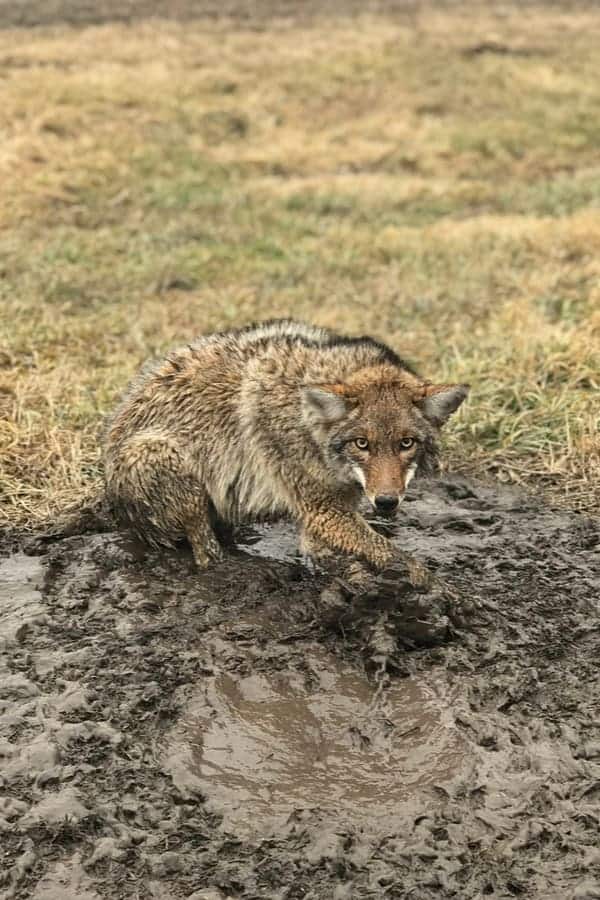
One of the most common ways that coyotes gain access is by slipping under a fence. But if you set the trap too close to your livestock, the coyote may get suspicious and sneak around it. Also, a top tip to live-trap coyotes is to scent it and spread that smell as far as it can go.
So as you’re dowsing the trap with meat or coyote pheromones, make sure the wind blows the scent towards the coyote, not away from it. Or set several traps at various compass points so that the aroma hits every coyote in the area. Hopefully, you’re attracting the right one!
19. Wear Protection
You don’t need hazmat, but you do need to cover as much of your body as possible. This serves two purposes. One, it will prevent you from getting scratches, knicks, or bites as you handle the trapped animal. But you need heavy protective gear before you catch the coyote as well.
This is because any sweat or scent that you leave on the trap could be a warning sign to the coyote. So avoid strong deodorants, shower before you trap to lower your natural BO, wear gloves, overalls, and head-gear to retain and trap your scent within your clothing. Good luck!
Do you have any tips to trap live coyotes? Share them with us in the comments section!








